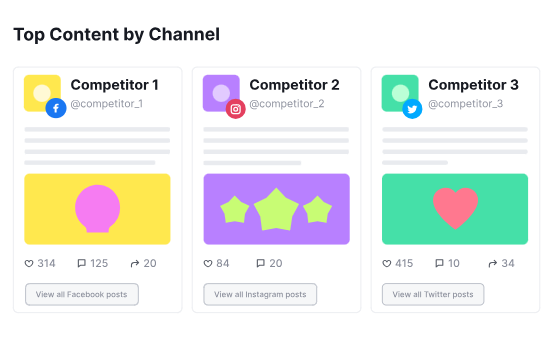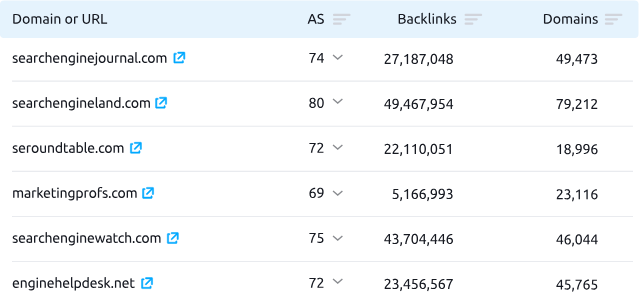Your search landscape rivals aren't just competition; they can also be an inspiration if you know how to learn from them. Many SEO pros and marketers struggle to go beyond surface-level insights, often falling into the trap of mimicking instead of strategically outsmarting competitors.
It's relatively simple to spot what others are doing. But how do you turn that into actionable, game-changing steps for your own strategy? Basically, it's a blend of two main things — one, getting a peek into how your competitors are approaching SEO, and two, figuring out where they're lacking or making mistakes.
This way, you don't only learn from their best strategies but also manage to outcompete them where they fall short. Now that AI's involvement in the SEO space has increased competitiveness by over 57%, it has become more important than ever to use competitive intelligence. Here's a guide to help you ace both these approaches.
- Unlocking SEO Success Through Competitive Intelligence
- Tools of the Trade: Top Platforms for SEO Spying
- Capitalize on Competitors' SEO Weaknesses
- Predict Their Next Move: Staying Ahead with Competitive Insights
- Win the Right Way: Ethical SEO Competitive Intelligence
- Stay One Step Ahead with SEO Competitive Intelligence
- Frequently Asked Questions
Unlocking SEO Success Through Competitive Intelligence
Competitive intelligence doesn't mean spying and replicating. Instead, it's a more thorough approach in which you spot gaps, inspect them, and fill them with your own unique approach. As Jake Ward, an agency founder, suggests, the first step is selecting the right competitors. Typically, you'd have two types of competitors: one that acquires your target customers and one that gets the traffic you want to get.
While you should focus on both, the latter is where your major insights into SEO success lie. So, identify the strengths and weaknesses of these competitors. For example, start by looking for outdated or thin content. They're leaving traffic on the table here.
Similarly, spot poor internal linking structures that disrupt user journeys or slow-loading pages that could hurt their rankings. On the flip side, take note of their strengths. Are they dominating specific keywords? Is their backlink profile top-notch? Use their successes as inspiration while focusing on where you can do better.
You need to take your competitors' websites as performance benchmarks because if they're getting the prime traffic, they're likely doing something right. Analyze their site's technical SEO, with a focus on factors like site speed, core web vitals, mobile responsiveness, markups, and international SEO.
Likewise, go through their content and keyword strategy. Identify how relevant or comparable their content is, both in terms of quantity and quality. Check for common keywords and topics across competing sites and assess how they address user intents compared to your approach.
All these tactics aren't a one-time analysis. You need to keep doing this continuously since competitor strategies are changing regularly. With real-time competitor analysis, you might even find yourself a step ahead, thanks to predictive SEO.
A simple example is noticing competitor use of certain keyword clusters that are currently on an uptrend. They may also be creating content around certain topics or getting backlinks from authoritative sources on these articles, indicating that their future strategy involves expanding their online authority in a particular niche.
Forecasting Competitor Strategies
With real-time competitor analysis, you might even find yourself a step ahead, thanks to predictive SEO. A simple example is noticing competitor use of certain keyword clusters that are currently on an uptrend.
They may also be creating content around certain topics or getting backlinks from authoritative sources on these articles, indicating that their future strategy involves expanding their topical authority in a particular niche.
You can predict these moves by analyzing their semantic gaps—areas where they've started building authority but haven't fully covered the topic. Tools like Semrush can help identify untapped keyword clusters that complement their existing content, giving you an idea of where they're likely to expand.
If this content shift is seasonal, you can also identify that with Semrush's competitor analysis tools. For example, Domain Overview can show you the top keywords bringing the most traffic to a competitor's site during a certain time during the year.
AI-driven competitive intelligence tools further simplify forecasting competitor strategies with ready-to-use predictive models. For example, predictive scoring models rank content potential based on current trends and search behavior, helping you find topics your competitors might tackle next based on their existing content's performance trajectory.
Plus, AI-powered sentiment analysis can monitor shifts in consumer behavior or industry chatter. Combine this with real-time competitor tracking, like backlink monitoring or SERP ranking changes, to get a sense of their next moves.
By combining these tools and strategies, you gain a clearer understanding of your competitors' plans and performance. This allows you to refine your own approach, capitalize on untapped opportunities, and position your brand to outperform the competition in key areas.
Tools of the Trade: Top Platforms for SEO Spying
Semrush is undoubtedly one of the best AI SEO tools, and its competitor analysis features make it an ideal solution for peeking into your competition's SEO strategies. These Semrush tools are the most suitable for competitive intelligence.
Market Explorer
As we've explained above, the first step in competitor analysis is selecting the right competitors. For example, if you're in the eCommerce apparel space, not every other eCommerce apparel store is your direct competition. Your main competitors are the websites that have the highest overlap with your organic search traffic.
The Semrush Market Explorer tool helps you find these websites. You can use the tool to find competitors in a certain region or worldwide. Enter at least 3 competitors to get started.
The Overview tab provides you with a snapshot of who you're competing with online, along with their growth rate, audience size, and relative market share.

Market Explorer tool
In the Growth Quadrant widget, you'll see which of your competitors are leaders, established players, niche players, and game changers. First, determine which of these categories your company stands in. Then, you can decide which of these competitors you should be most concerned about.
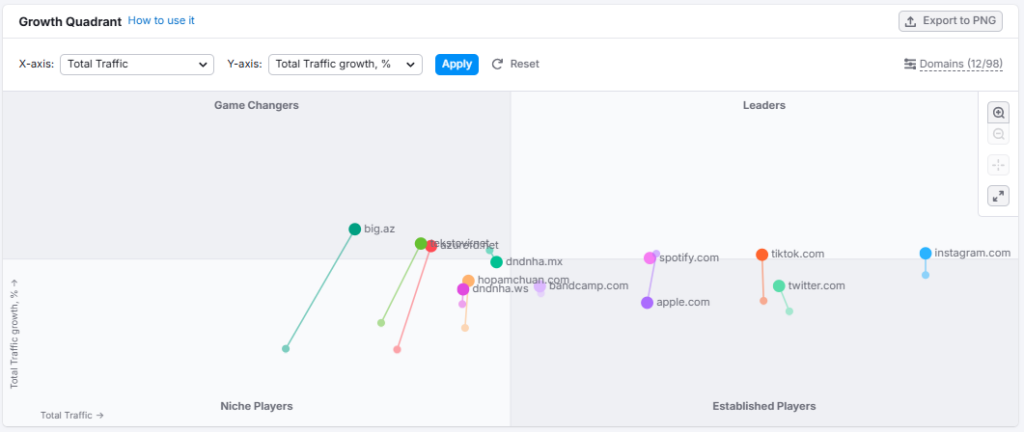
Growth quadrant in Semrush
The Benchmarking tab shows you how these competitors compare to the market standards in terms of domain traffic, social media distribution, and other factors. From here, you can get an idea of which competitors are performing better in certain areas and channels.
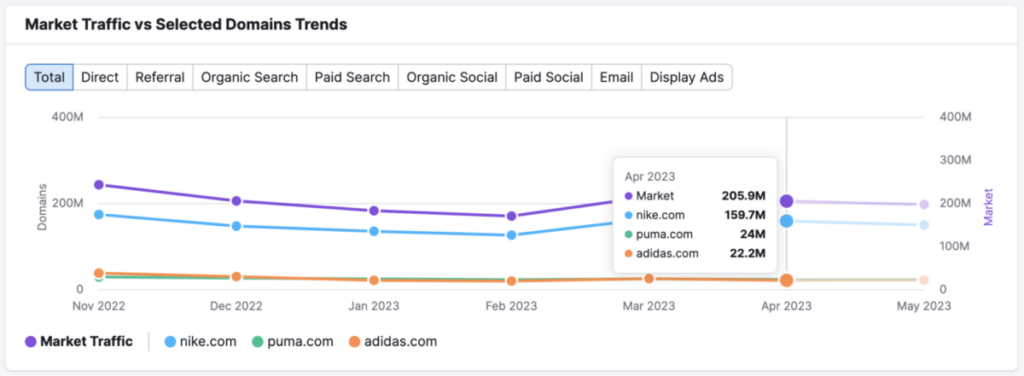
Benchmarking report
The Audience tab provides demographic and behavioral data about their audience, including age, sex, income, social media usage, and more. Take note of competitors that have the highest overlap with your audience, as they are the ones stealing potential customers from you.
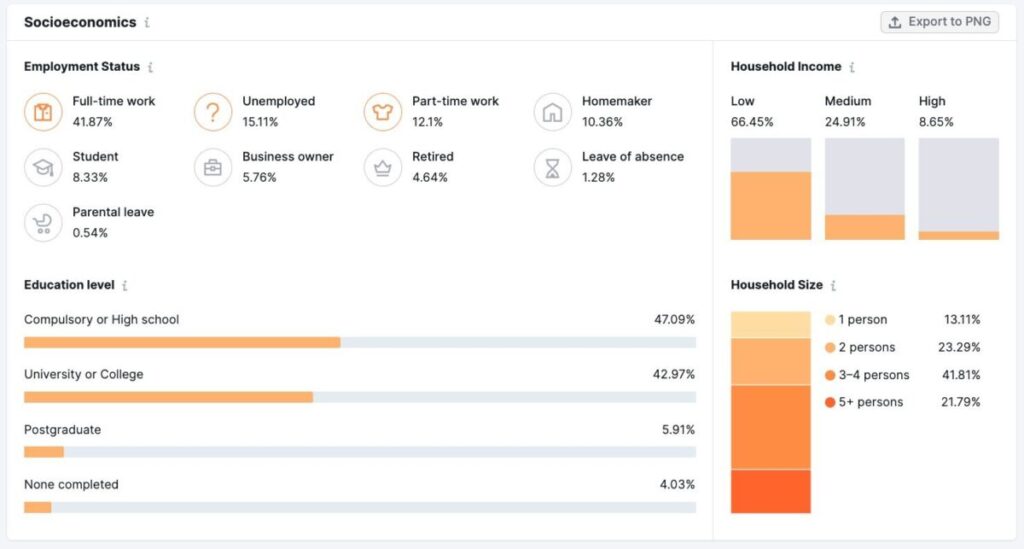
Audience report in Semrush
Keyword Gap
The Keyword Gap tool shows you the difference between the queries you're ranking for and those of your competitors. More importantly, it shows you where competitors are taking up SERP space and you're not. Each of these keywords is a missed opportunity for you to grab.

Keyword Gap tool
You can enter up to four competitors in the Keyword Gap tool for comparison. In the table, the Missing filter will show you the keywords you don't rank for, but the competition does. These keywords can now go into your content strategy.
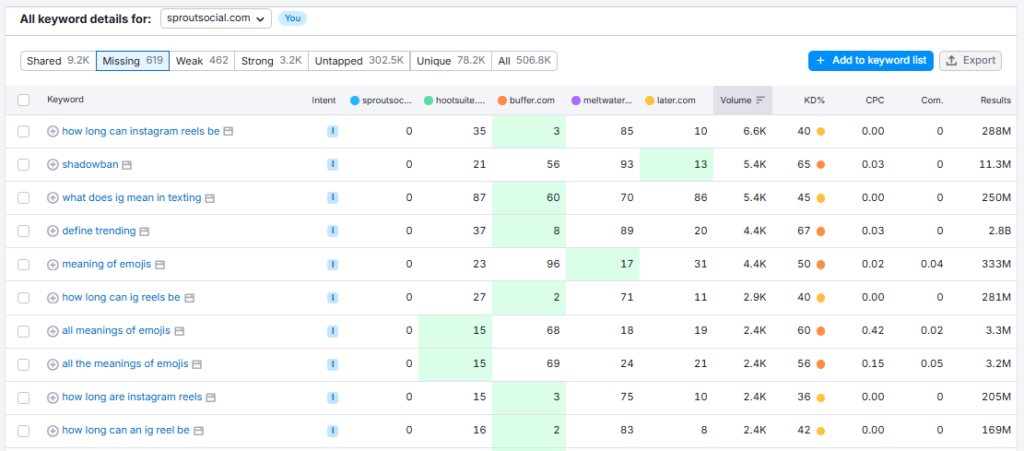
Missing keywords
Similarly, the Untapped filter shows keywords that have been targeted by only one of the four competitors, presenting an opportunity for you to dominate in that area due to low competition.
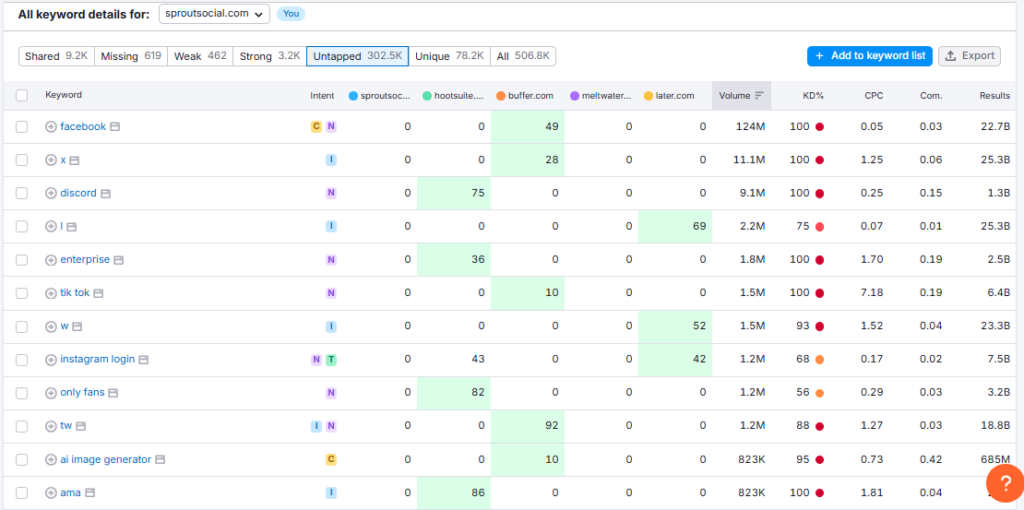
Untapped keywords
Look at the search volume of these keywords and combine insights from other predictive tools to identify the terms that are or will be gaining traction soon.
Organic Research
The Organic Research tool helps analyze competitor content, showing you which strategies rivals may be using to get their content ranked so high. Enter the domain of the competitor you want to assess.
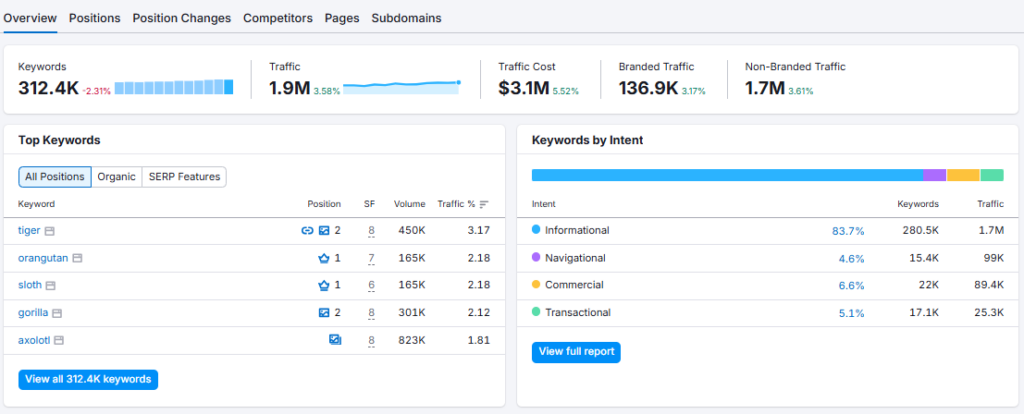
Organic Research
Then, go to the Pages tab. Here, you'll see the top-performing pages on this domain, along with their estimated traffic. You can click on the arrow next to each page to see the URL where it's posted.
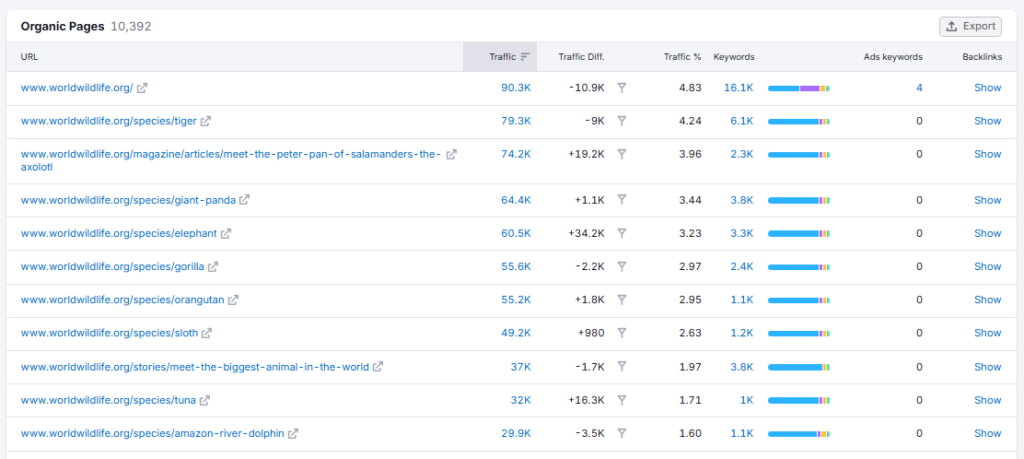
Organic Pages in Semrush
Examine this content to look for patterns in topics, keywords, and format. Are they focusing on long-tail keywords? Do they use a lot of visuals or video? Maybe most of their content is long-form and in-depth. These insights can help you curate your own content accordingly.
The Position Changes tab may assist you in forecasting your competitor's future content strategies. Take note of their top pages that have recently gained significant positions. Semrush also shows you the keywords used on these pages. It's likely your competitor is capitalizing on a new trend or an up-and-coming keyword, and their efforts have started paying off.

Position Changes
Look for keywords that have had an uptrend in search volume and add them to your list of potential keywords. To do this, select ‘’New’’ from the Position Changes drop-down. Semrush will then show you the new queries the competitor has started ranking for.

Semrush filters
You can also research the topics of their pages and brainstorm ways to create similar but better content that addresses the same search intent.
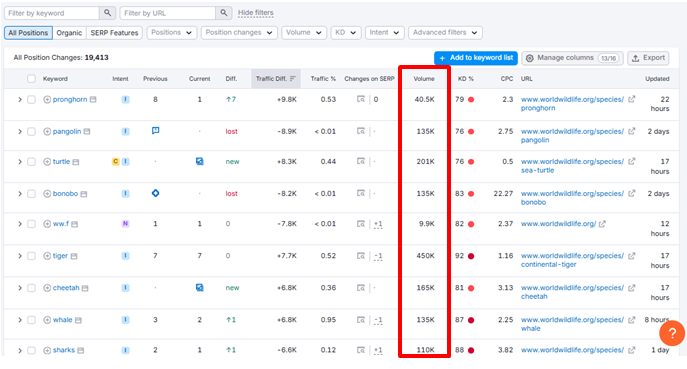
Search volume in Position Changes
Backlink Gap
It's also important to keep an eye on your competitors' backlink strategies, such as which websites are linking to their content and not yours. The Backlink Gap tool does this for you.
Enter the competitors you want to stack your backlink profile against and click on ''Find Prospects.''
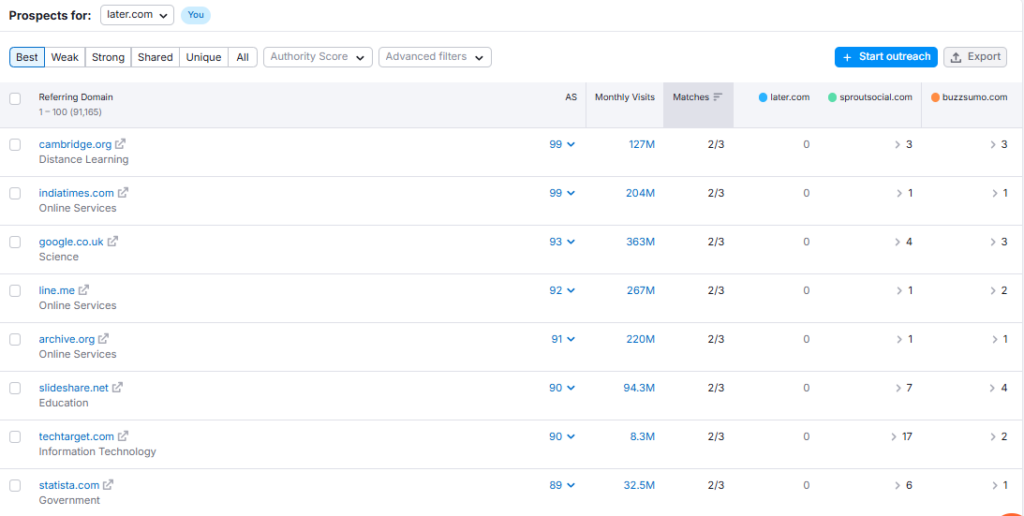
Backlink Gap tool
You'll see a table just like you did in the Keyword Gap tool, where you can find the following backlinks:
- Best: These are the domains that link to all competitors you've entered but not you. These are must-target websites for your outreach strategy since they're surely interested in your topic and have already linked to similar content.
- Unique: This filter shows you the domains that only link to one competitor. You can also target them to outperform the other competitors you've entered who don't have a backlink from this source.
- Weak: While these domains link to your website (as well as the competitors'), they're not linking to you as frequently as they are to your competition. You can prioritize these websites for outreach and try to increase the frequency of their backlinks to your content.
From here, you can select the best websites for outreach based on their authority score and monthly organic traffic.
Traffic Analytics
The Semrush Traffic Analytics tool helps you explore your competitors' growth points and website traffic stats to understand what drives their traffic. In the Overview tab, you can find the total visits, unique visitors, and purchase conversion for their domain over the past 12 months or since the beginning of their website.
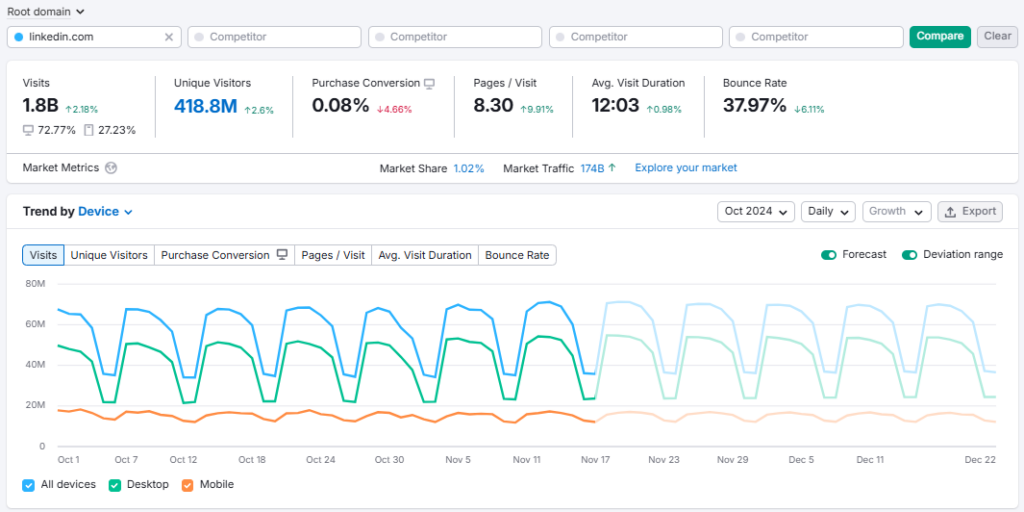
Traffic Analytics
The tool also shows you the traffic channels your competitor is dominating. Plus, you can see how much of their traffic they get from these channels, including direct, referral, organic search, paid search, and so on.

Competitor traffic channels
The Audience Journey section gives you a sneak peek into where their visitors come from and where they land. For example, they may come from Google and go to their homepage.
You can use these insights to streamline your audience's journey accordingly. Our in-depth guide on competitor traffic analysis provides detailed instructions on how to use this information to outdo your competitors.
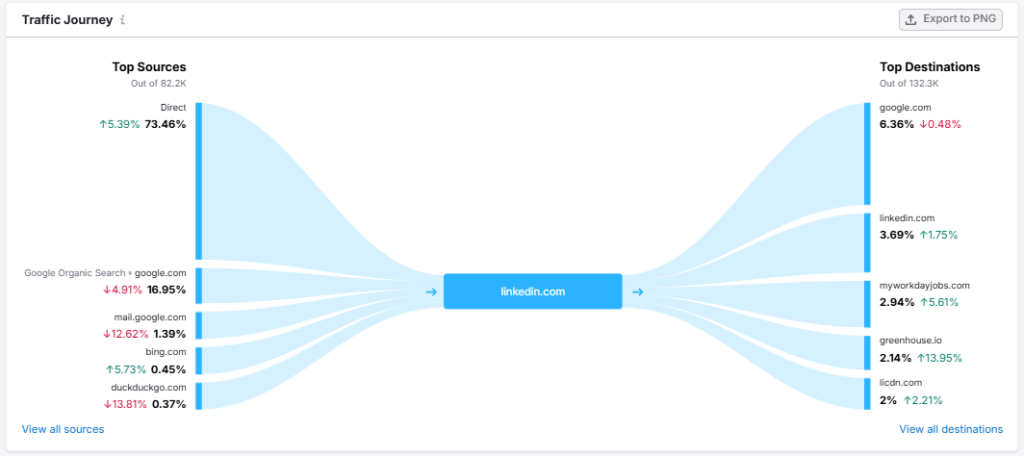
Traffic Journey
Capitalize on Competitors' SEO Weaknesses
The first step of finding and then learning from your competitors' SEO gaps is rounding up the competition. As we've mentioned earlier, the Semrush Market Explorer tool is an excellent resource in this regard, helping you find competitors in your market. You can also use Organic Research or Traffic Analytics to find competition by audience overlap or traffic distribution.
Next, look for pages where competitors are losing organic positions in the Position Changes tab of Organic Research. This is an opportunity for you to direct their traffic to your website by creating content that fills the gap and is more in line with the current algorithm and audience preferences.
In the same vein, the Keyword Gap tool shows you long-tail keywords you or your competitor may be overlooking. Identify the keywords your direct competitors have missed and create content for the ones that show a search volume uptrend since these are likely to bring in more traffic and potential customers in the near future.
You can also use Domain Overview to see your competitors' organic keywords and SERP positions. The tool provides an overall view of a website, from its organic and paid traffic to the SERP features it appears in. In the Compare Domains tab, you can analyze the competitor's website against yours to find missing keyword opportunities for your content.
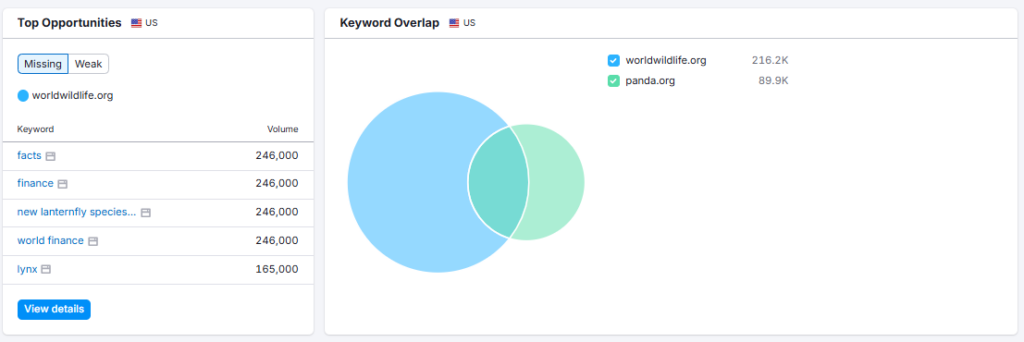
Domain Overview
Go a step further by using social listening to get a sense of consumer sentiment about your competitors. These insights will tell you how people respond to the competition's content. For example, if social media users are indulging in negative conversations about your rival due to their recent content campaign that may have come off as offensive, this is a learning opportunity for you.
With Semrush Social, you can track your competitors' accounts across major social media platforms and stack their performance against your key performance indicators (KPIs). It also provides you with daily engagement reports, which help you determine if a certain content strategy is delivering the desired results.
Besides content and keyword strategies, the technical aspects of your competitors' websites are just as important. Use the Semrush Site Audit tool to find your rival's technical SEO weaknesses, such as poor markup use or slow site speeds. You can then ensure these issues are not present on your website, giving you a competitive advantage in terms of user experience and search engine rankings.
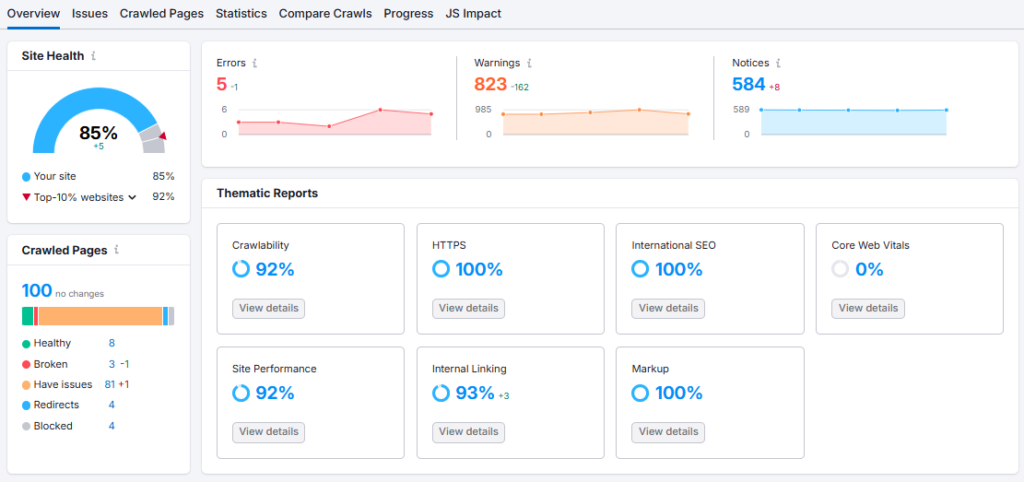
Semrush Site Audit
As we touched on earlier, you can also steal your rival's search engine rankings through backlink analysis. Use the Backlink Gap tool to find high-authority websites with substantial organic traffic from which you can potentially acquire backlinks. If you have a ton of competitors, you can analyze their backlink profiles together using the Bulk Backlink Analysis tool. It lets you assess 200 competitors to find link-building opportunities.
Tailor Competitor Insights to Your Brand
Regardless of the insights you're learning from, it's imperative not to blindly copy your competition. Instead, only use the crux of their strategy and build your own that aligns with your brand's identifying elements, such as tone, voice, and style.
For example, a competitor's content may have a playful and humorous tone. However, your brand style may be more professional and serious. You can use their content ideas and keywords but create content in a voice your audience is used to.
Similarly, you may focus on a certain audience segment while your competitors cater to a different demographic. Suppose you have a blog where you share home improvement tips. Your competitor's content may not account for budget and accessibility, but your audience is predominantly young homeowners on a tight budget.
So, you can take inspiration from their content, such as tips for creating multifunctional spaces, but give it your budget-friendly and accessible spin.
Predict Their Next Move: Staying Ahead with Competitive Insights
In SEO, it's not enough to match your competitors; you need to outpace them. Staying ahead means actively monitoring their moves, anticipating shifts, and capitalizing on areas they've overlooked. For this, you need a tracking tool that updates regularly. Connor Gillivan, the founder of TrioSEO and The Savvy SEO, ranks Semrush as the top tool for SEO competitor analysis, and we agree.
The EyeOn tool allows you to keep a close eye on multiple competitors at once. It alerts you when they post new content or run new ads. You can also track their new pages for pricing changes or product releases.
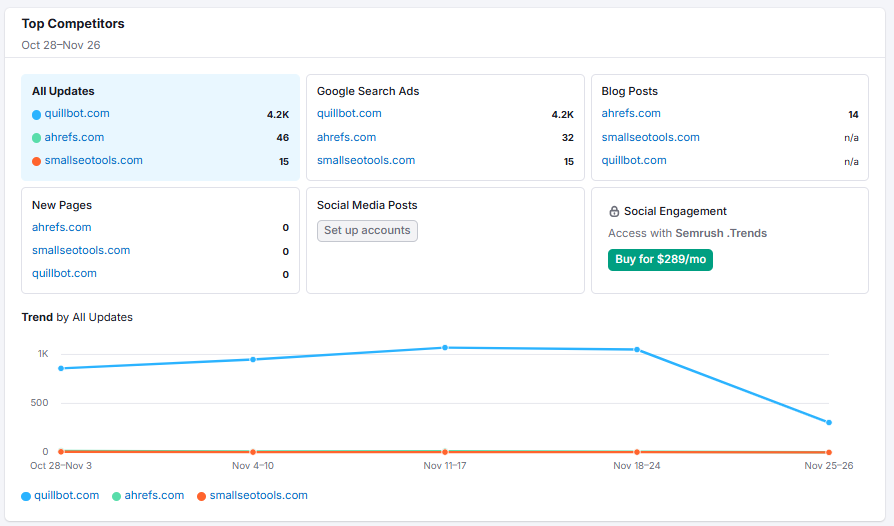
Semrush EyeOn
It shows competitor activity graphs where you may identify cyclical and seasonal trends. Since you get weekly emails specifying competitor content and campaigns, you can update your SEO strategy without delay to match their new moves.
As you notice new content themes or keywords in these reports, these could be signals for emerging trends. For example, if most of your competitors seem to be focusing on a new content angle, there's a good chance that it's aligning with an emerging audience interest.
Once you spot emerging themes, act fast. Create a content calendar prioritizing these topics, optimizing for both trending keywords and related semantic phrases. For example, if a competitor starts focusing on "AI in eCommerce," you could preemptively create in-depth guides on "AI tools for small e-commerce businesses" or "How AI personalizes the online shopping experience."
Don't merely follow in your competitors' footsteps, though. Also, notice where they're lacking and build authority in those spaces. Here's how Semrush helps:
- Use Market Explorer to find out which traffic channels a competitor is not leveraging as well as other players in the industry.
- Identify niche yet high-authority domains that competitors haven't tapped into yet using the Backlink Gap tool.
- Use the Keyword Gap tool to identify keywords that your competitors are not ranking for yet.
- Use Organic Research to identify pages and keywords your competitor has lost SERP positions for and find gaps in their content that you can fill.
- Check the Audience Overview tab in Traffic Analytics to see which social media platforms your target prospects are most active on. Then, use Semrush Social to view your competitor's presence on these platforms. Wherever they are lacking, try to establish your brand as an authoritative figure on those social media sites.
Your competitor's insights should feed into a cycle of continuous improvement. Schedule regular reviews of your SEO strategy based on competitor moves, market shifts, and audience feedback. A quarterly strategy review is a great starting point where you evaluate:
- Competitor updates: Are they investing heavily in new keywords, platforms, or link-building tactics?
- Market trends: Are there industry shifts requiring a pivot in your content strategy?
- Audience insights: How is your target audience engaging compared to theirs?
This process ensures you're not just reacting to competitors but refining your approach to consistently stay ahead.
Win the Right Way: Ethical SEO Competitive Intelligence
Spying on your competitors' strategies doesn't mean taking unethical routes to gain an advantage. It's important to stay within ethical boundaries and not resort to any black hat tactics that may hurt your website's credibility in the long run. Avoid scraping your competitors' content or replicating their tactics without proper research and analysis.
Instead, focus on high-quality content, insightful keyword strategies, data-driven backlink building, and targeted audience engagement.
For example, instead of trying to outdo competitors with keyword stuffing, which won't be effective in the new AI SEO space, produce valuable, audience-centric content. This approach not only wins Google's favor but also builds audience trust, which is something shady tactics can never achieve.
Most importantly, do not get carried away with competitive intelligence. Your unique brand voice and goals should always be at the forefront of your SEO strategies. Competitor insights are mere additions or tweaks to your existing strategy, not a complete copy-paste approach.
Stay One Step Ahead with SEO Competitive Intelligence
There's a lot you can learn from your competitors, such as which keywords are on the rise and which content topics are generating the most engagement. However, simply collecting this data isn't enough. You have to act on it, too. Whether it's filling content gaps, targeting overlooked keywords, or enhancing technical SEO, the goal is to refine your approach in ways that meet user and search engine interests.
Semrush serves as a comprehensive SEO software for agencies, marketing teams, and solo marketers alike. Use it to its full potential for competitive analysis in terms of keywords, content, backlinks, predictive SEO, and more. However, always keep your brand's unique objectives, tone, voice, and audience preferences in mind.
Frequently Asked Questions
What is SEO competitive intelligence?
SEO competitive intelligence is about analyzing your competitors' strategies to uncover what's working for them, like keywords, backlinks, or content, and finding gaps you can exploit. It's not about copying but learning from their strengths and weaknesses to improve your own SEO game.
What are the best tools for competitive intelligence?
Semrush is a comprehensive tool for competitive intelligence. Keyword Gap helps find untapped keywords, Backlink Analytics reveals your competitors' link strategies and Traffic Analytics gives you a peek at their website performance. Pair these with Position Tracking to monitor rankings as you adjust your strategy.
How can I find keyword gaps between my website and my competitors?
You can use Semrush's Keyword Gap tool for this. Just plug in your website and your competitors' domains. It shows keywords they rank for, but you don't, along with untapped opportunities. Focus on "missing" and "weak" keywords to spot gaps and refine your content strategy.
Can AI tools handle competitive intelligence analysis?
AI tools can analyze tons of data, like keywords and backlinks, much faster than manual methods. They even have smart features that curate the data for you in visual formats for better understanding. Some of them also provide predictive insights that you can couple with human judgment to make better decisions about outperforming competitors.
How do I analyze a competitor's backlinks?
Use Semrush's Backlink Analytics to analyze your rival's backlinks. It shows you where your competitors are getting their links from, their backlink quality, and domain authority. To find link-building opportunities, try the Backlink Gap tool to find websites linking to your competitors but not to you.
Are there any free tools for competitive intelligence?
You can try Semrush's Domain Overview for a quick look at a competitor's traffic, keywords, and backlinks. Or, you can sign up for free to use the Semrush Backlink Analytics tool to get a peek into a rival's backlink profile.
How do I monitor competitors' SEO updates?
Use the Semrush EyeOn tool to monitor your rivals' SEO updates, such as new content or social media engagement. You can also view their new pages, ads, positioning efforts, or promos. The tool sends you alerts as competitor strategy shifts.
What is a keyword gap analysis?
Keyword gap analysis is when you compare the keywords your site ranks for with those your competitors rank for. It helps you find keywords they're targeting, but you're missing, giving you opportunities to optimize your content and capture additional traffic.
How can I improve my content based on competitor analysis?
There's a two-way approach to this. One, find content your competitors aren't doing too well at, such as missing topics or outdated information. Then, create better content on those topics to fill the gap. Two, find the top-performing content from your competitors and analyze what makes it successful. Use this information to improve your own content and make it stand out from the competition.
Can competitive intelligence help with content strategy?
Competitive intelligence helps by showing you what topics, trends, keywords, channels, and formats your competitors are excelling at. You can spot content gaps, discover trending topics, and understand what your audience wants. Then, it's just a matter of acting on these findings to outshine your competitors.
